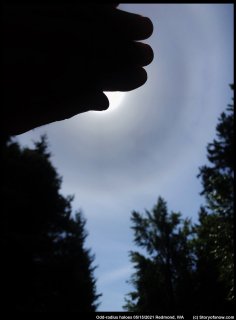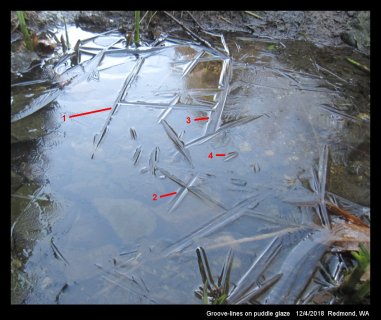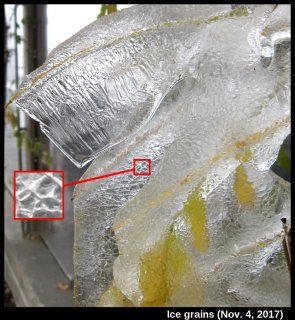Category: "Polycrystalline ice"
Odd Radius Haloes and Pyramidal Crystal Faces
February 19th, 2022Out walking one day last spring, I sensed a subdued illumination--like a thin veil of cloud had drifted in front of the sun. I looked up, and indeed found that there was. Blocking out the sun with my hand, I surveyed the thin veil and saw a strange sight: instead of the usual 22-degree halo around the sun, I saw what looked like two closely spaced haloes near the usual 22-degree spot. I took a picture:
Below, I mark the positions of the observed haloes in green and in black the position that the common 22-degree halo should be.
Puddle gets its grooves (upon freezing), part I
February 16th, 2019These grooves appear on the surface of frozen puddles.
Most grooves are straight lines, and most of these also appear to have relatively symmetric sides, such as those marked #s 1, 2, & 4 in the above image. But some, such as #3, have sides that are much wider. Grooves can intersect each other at a "T" intersection, such as #1 and #3, or they can cross, as a 4-way intersection as in #2. Some, such as #4 start and end on nothing apparent and intersect no other grooves.
Sometimes the sides show small steps or sub-grooves, particularly on the wider sides, such as on #3. On grooves that curve, such as in #1 and #2 in the image below, one side can have a fern or foliage type of texture.
Grain boundaries between crystals in big ice
November 6th, 2017Most snow crystals are single crystals. Being single is an outcome of their growth process and small size. On the other hand, most larger ice formations are not single crystals. These latter types are called "polycrystals". A polycrystal usually appears the same as any other type of ice -- smooth, uniform, clear or white -- just as if it were also single crystal. But the poly nature can be revealed when the ice warms to the melting temperature. At melting temperature, the boundaries between the separate crystals become visible. As an example, note the white lines in the ice in the inset in the image below.
(This image is from the ice drip complex in the previous post.) We call each individual crystal a "grain", and the boundaries between grains as "grain boundaries". The grain boundaries show up because the region has disordered ice that will melt at a lower temperature than regular ice. Thus, the light, upon passing through a grain boundary, will scatter more, making a whiter region, as shown in the image.
The ice is thus weaker on a grain boundary and has a tendency to break along these boundaries. On the surface of ponds and lakes, the grains (individual crystals) can be several inches or more across. So, if you get a sheet of such ice, and let it warm up to melting, you will find it easy to break the ice sheet along a grain boundary and thus isolate a large single crystal.
The size and pattern of the grains affect the mechanical properties of the ice. So, glaciologists, who want to know how a given glacier or ice sheet moves, are very interested in such patterns. They call this pattern the "ice fabric".
-JN



